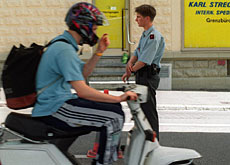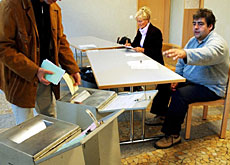Number of cross-border commuters stabilises

A bilateral agreement allowing European Union citizens to work in Switzerland has not led to an explosion in cross-border commuters, says a new study.
The Federal Statistics Office said there were 174,700 such workers in the country at the end of 2004 – only 3.2 per cent more than the previous year.
According to the report, the number of cross-border commuters has risen by 27 per cent since 1999 and made up 4.2 per cent of those working in Switzerland at the end of last year.
But its authors could find no evidence of a much-feared influx of EU workers after June 2002, when the bilateral agreement on the free movement of citizens of the EU’s 15 original members came into force.
“The coming into force of the bilateral accord… on June 1, 2002, as well as the abandoning on June 1, 2004 of priority being given to Swiss workers [on the job market] and of controls of salaries and working conditions has not been followed by a massive rise of cross-border workers,” said the office in a statement.
It added that there had been a rise of 7.8 per cent in these workers at the end of 2001, but the number had stabilized at around three per cent between 2002 and 2004.
France leads
More than half of cross-border commuters came from France, followed by Italians (22 per cent) and Germans (20 per cent).
The most favoured regions were northwest Switzerland, the area around Lake Geneva and the Italian-speaking region of Ticino.
The office noted that there had been a boom in cross-border workers in business services and the health sector over the last five years. It added, however, that a majority of foreign commuters still worked in industry (42 per cent).
Overall, almost two-thirds of those crossing the border into Switzerland for work purposes were men. But the number of women has risen by 31 per cent over the last five years compared with 26 per cent for men.
Working over the border is also becoming more popular among young people with a more than 80-per-cent increase among those aged between 22 and 24 and a 44-per-cent rise among 25-29 year olds.
The average cross-border worker is aged between 25 and 54.
Swiss citizens are due to vote on whether to extend the free movement agreement to the EU’s ten new – and mostly eastern European – member states in September.
swissinfo with agencies
Cross-border workers at end of 2004: 174,700.
Rise on 2003: 3.2%
They made up 3.6 per cent of workforce at end 1999.
At end of 2004 this had risen to 4.2%
Number of border workers in primary sector: 1,400.
In secondary sector: 73,500.
In tertiary sector: 99,800.
Treaty on free movement of people entered into force on June 1, 2002.
Two years later, priority for Swiss nationals was abolished, and measures to prevent wage dumping introduced.
All citizens of the original EU members are now permitted to commute into Switzerland.
They are no longer obliged to return every day to their country of origin, but must go back each week.

In compliance with the JTI standards
More: SWI swissinfo.ch certified by the Journalism Trust Initiative


You can find an overview of ongoing debates with our journalists here. Please join us!
If you want to start a conversation about a topic raised in this article or want to report factual errors, email us at english@swissinfo.ch.